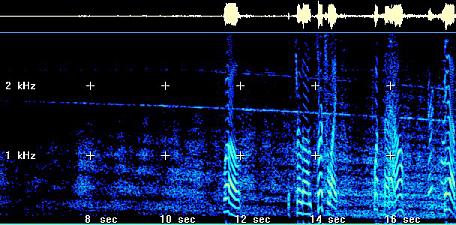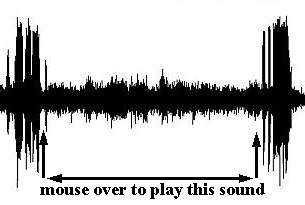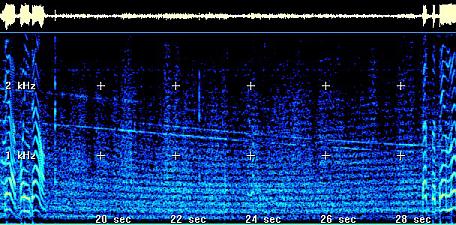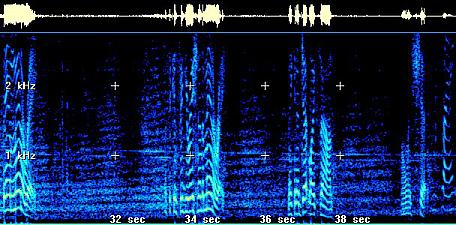The sound produced by the Manta Ray could easily pass for that of jet engine(s) to the untrained ear, but there are significant differences when compared to sounds recorded for conventional jets. These differences include:
Absence of white noise. Conventional jet engines produce white noise between 2 Kilohertz and 10 Kilohertz.
Multiple independent frequencies or bundles of distinct frequencies, most of which are less than two Kilohertz. Conventional jet engines produce a continuous gradation of frequencies up to and above two Kilohertz, with some embedded individual frequencies.
Reversed Doppler effect. Conventional jetliners produce a normal Doppler effect of increasing frequencies as the jetliner approaches the mic, and decreasing frequencies as the jetliner moves away from the mic. The exact opposite occurs (can occur) for the Manta Ray.
Spectrogram segments combined (audio resampled at lower rate to conserve download size; high frequencies and noise muted).
|
Combining the first two spectrograms to show decreasing suite of frequencies, and evidence for a reversed Doppler.
|
Original unaltered sound with static noise, which is present on the audio tract only when the craft was directly overhead (implication?):
Spectrogram of mouse-over sound file displayed below. Note how frequencies bottom out as craft passed overhead.
|
Reversed Doppler effect indicated by rising frequencies after craft passed mic.
|
An Advanced Propulsion System
The reversed Doppler tells us something significant about the propulsion system. In order for the Doppler effect to be reversed, the cause of Doppler must first be examined: As a sound source, such as a car horn, approaches the listener, the fact that it approaches at a speed greater than zero means that the frequency is compressed by a factor of velocity. When the frequency is compressed, its apparent rate of oscillation increases. Because rate of oscillation (i.e. frequency) determines pitch, we hear a higher relative frequency.
As the sound source moves away from the listener, the opposite happens. The time it takes for the sound to reach the listener is increased by the same factor of velocity. As the rate of oscillation is stretched relative to the listener, we hear a lower relative frequency.
For reversed Doppler to occur, the opposite must be happening. The frequency must be stretched as the sound source approaches the listener, and compressed as it moves away from the listener. But how could this happen?
A jet engine creates a vacuum in front of the intake, and compresses air behind it to create thrust. The amount of vacuum is minor compared to the amount of thrust, because fuel is added to the airflow and ignited, producing expanding gases out the exhaust. The amount of compression is focussed and limited, however. Because the vacuum in front and the amount of compression behind a jet engine are limited, any reversal of Doppler is minor. The volume of sound coming from the engine's spinning turbines tends to drown out that reversal. For reversed Doppler to be heard, its influence must extend well beyond the immediate proximity of the source.
The decrease in frequencies for AOP begins as far away as a quarter mile (1,000 feet), and the increase in frequencies after the AOP passes the mic continues for more than half that distance. That means that the "cone of influence" producing the reversed Doppler is enormous, and extends all the way to the ground and to any listener on the ground when the AOP is 1,000 feet or less in altitude.
If the propulsion system stretches space in front of it, and compresses space behind it within an imaginary sphere around the AOP (a sphere with a radius of 1,000 feet, for example), we could have an explanation for the reversed Doppler and the recorded characteristics of it (see A BUSY NIGHT at the hotspot with recordings of weird sounds). But for space to be stretched like a vacuum in front and compressed behind the AOP, something other than a turbine jet engine must be involved - something much more powerful. An engine that influences gravity is the only force strong enough to reverse the Doppler effect to this extent.
A video of the Manta Ray recorded on 29 April 1993 as the craft approached the camera and then turned and moved away shows a pair of parallel lights on its belly being warped or distorted. That rows of lights are strongly convergent towards the camera on approach, parallel overhead, and divergent away from the camera on departure - like the sound.
Cornet interpreted this effect in The Performance to be the result of a force capable of bending light, a force that could only be caused by the manipulation of gravity through the controlled cancellation and augmentation of mass (see Light Bending Technology).
In conclusion, the reversed Doppler effect, together with the bending of light, are two powerful pieces of data supporting the existence of an electrogravitic mass-avoidance propulsion system. See Estimate of the Situation 2000: The Black Triangles.
Question is, Who designed and built it?
Discussion and Conclusion next (with promo for SETV).
Send mail to bcornet@direcway.com
with questions or comments about this web site.
Copyright © 2000 Sirius Onion Works.
This page was last edited 09/15/2005






